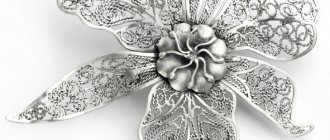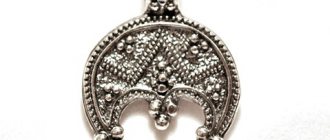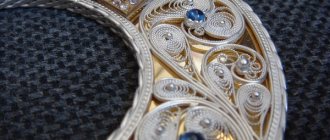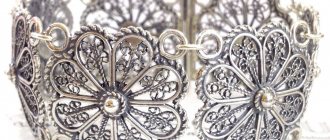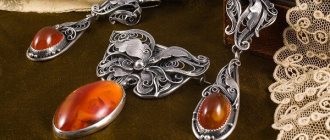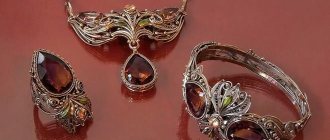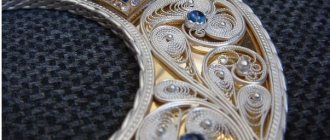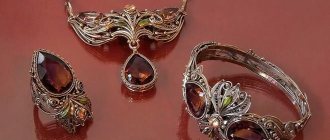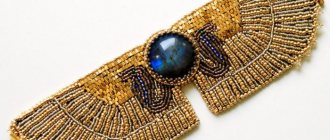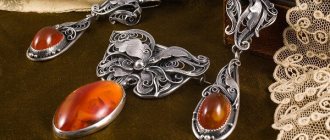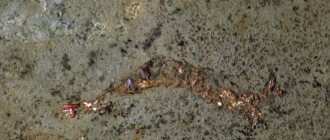Filigree (in Russian - scan) is a pattern of thin wire soldered onto metal. Almost everyone has encountered filigree; many families probably have preserved objects made using this jewelry art.
The word “filigree” itself seems to hint at the production technology. Translated from Latin, “filum” means thread, and “granum” means grain. The Russian word “skan” comes from the Old Russian “skat”, which means “to twist, twist”. This technique is mainly used on silver items, such as spoons, coasters, and women's earrings, but the material can also be other precious metals such as gold and platinum.
The reason for the fascination with silver and gold is the softness of these metals; very thin wires can be twisted from them. The basis of filigree is silver or gold wire, which can be either smooth or twisted into a kind of rope.
A Brief History of Filigree
If we turn to the history of its origin, it will take us to ancient Egypt, Crete and Greece. Already in the 4th-6th centuries BC. filigree was one of the basic jewelry techniques for making openwork jewelry.
In the 17th century, the demand for filigree jewelry increased. In the 18th century, filigree was combined with stones, crystal, and mother-of-pearl. Using filigree, vases, salt shakers, and boxes are made. Since the 19th century, filigree has become a manufactured commodity. The art is improving, relief openwork filigree is flourishing, and a stained glass variety with transparent enamel appears. In 1937, the work of jewelers from the village of Krasnoe-on-Volga was shown at the world exhibition in Paris, where it created a real sensation, and in 1939 the success was repeated in New York. Filigree began to be worked in the village of Kazachkovo, Nizhny Novgorod region.
Grain and filigree of Ancient Rus'
The technique of making jewelry began to be used on the territory of the Russian state in the 10th century. This period is characterized by an abundance of grains of different sizes and a small variety of filigree elements. Then the production technology developed to the production of soldered filigree; from the 12th century, craftsmen mastered the technique of openwork, relief filigree.
During the time of Tsarist Russia, filigree items were made in different sizes - from large-scale canvases to small brooches and earrings. The most famous masters were Ambrose and Ivan Fomin, whose products have survived to this day.
False (cast) filigree and grain
These techniques appeared to reduce the cost of the manufacturing process and speed it up. False (cast) filigree and grain are products cast in pre-made slate and limestone molds. Such decorations are similar to the original filigree decorations, but differed from them in simpler, smooth designs without relief.
Types of filigree
If we consider the types of filigree, then it can be soldered, openwork and volumetric.
- Soldered filigree . In it, wire and grain are soldered directly onto sheet metal. If you leave the background, you get background or so-called “deaf” filigree.
- Perforated (cut) filigree . Created by removing the background.
- Relief filigree . In this case, the pattern is soldered onto the embossed relief.
- Openwork filigree . The metal base is completely absent, the wire pattern is soldered, and the grain is attached to the metal lace. The lace itself can be flat, then it is a flat openwork filigree, but if the soldering occurs in two dimensions, then the result is a sculptural openwork type. Openwork, without a background, is usually called Russian filigree.
- Volumetric filigree consists of parts mounted into a single composition. This is how objects of jewelry are created, such as all kinds of cups, trays, caskets and vases.
Grain
In Russian jewelry art, filigree and granulation techniques are inextricably linked. Grain is usually used to complement filigree patterns, giving them a fuller and more finished look. The simple name of the technique fully reflects its essence. Grain is an ornament created from small, 0.3-0.4 mm in diameter, gold, silver or platinum grains. The balls are installed in pre-prepared recesses in the pattern on a thin layer of solder, which fuses them with the base in the flame of the burner. It is important that the solder can securely secure the pattern, but does not disrupt its clarity by spreading beyond the recess. In Rus', gold leaf mixed with mercury was used for these purposes; during the soldering process, the mercury burned out, and the gold quickly melted, forming a reliable adhesion.
Another condition for creating a high-quality pattern is the same size of all grains. To obtain them, thin wire is cut into small pieces, which are placed on pieces of charcoal, where recesses of a given diameter are located in rows; the molten wire flows into them, forming small balls, which will later be used for decoration.
Filigree techniques in the world
Beautiful lace is by no means a Russian folk craft. Filigree products are made by artisans all over the globe. Let's turn to world practices and their features. There are several main modern schools of filigree.
In Armenia they are used to making thin and flat shapes. In Dagestan they love abundant grains and hemispheres. In the glorious ancient Russian city of Kostroma, complex volumetric shapes of products prevail. European jewelers from France and England are also no strangers to filigree craftsmanship. Moreover, you can find openwork patterns in Latin American jewelry, for example, from Ecuador. In South America, the scanner fishery is generally quite developed.
LiveInternetLiveInternet
square dance master
source https://www.supersadovnik.ru
I have never hidden my interest in filigree and have long been looking for an opportunity to do something in its spirit. I was not satisfied with the replacement materials. The most pliable of them are threads and they become shaggy ((. Quilling is not practical! But at some point the sclerosis was released and it began to twist! . First, a few words about the filigree itself. The process of making filigree is very interesting, but labor-intensive. First of all, the wire, clear The thing is, they don’t take old cables, but make them by hand. Then they twist it in several steps with intermediate annealing and bleaching in acids. The wire is annealed so that it becomes softer and more elastic. After all, the wire must be twisted so that the turns are perpendicular to the axis. For Twisting alone will not achieve this - it breaks. Then the twisted wire is passed through rollers to flatten it. The ratio of thickness and width is at least 1:3. The number of devices for winding patterns is frighteningly large, the names are brain removal. Each connection is filed so that it does not scratch. But this is not the most important thing! The product of a real master is distinguished by the absence of traces of soldering! I will not list what is needed in order to solder it well. This is already the highest matter))). How to apply this for our needs. Precious metals are swept away. What remains is available copper and industrial silver. The melting point of copper is just over 1000 degrees. Having a gas burner, annealing can be done; you don’t want to mess with acid, but it’s also possible. That is, it is possible to obtain the wire of the desired twist with a certain amount of training. You can squeeze your husband and get rollers. You can twist patterns without buying jewelry tools, the result will be worse, but it will be there. For me, soldering is very problematic. But if we have done all this, what do we get as a result? That's right - a piece of jewelry))). And a legitimate question arises - why stick it on the bottle then? Therefore - “filigree-light”)))). Now about sclerosis! Ladies my age remember how in the 80s chains consisting of links of twisted wire were in fashion. Beaten, polished or simply round. This was done very simply, one might say on the knee. One twisting device is enough. This is the device my sister’s husband brought me. And even a coil of wire with technical silver. I didn’t make chains, but I had earrings to go with all my outfits, beads, beads and twisted wire. The fashion has passed, but the adaptation remains. And in a moment of enlightenment, I remembered her!! The size of the "beast" is small. just right for chains - 8 centimeters. It’s quite suitable for small elements, but it’s difficult to make a long outline of a picture from parts! I couldn’t think of anything to twist long wires. Until my husband got into the moment. As a result, I have two such devices. Real filigree is turned using a vice and some kind of mechanical rotating contraption. This is necessary so that there is some play in the wire. As it twists, it shortens. By loosening it a little, you can give it the opportunity to spin some more. That’s why my second device has a removable handle. The wire itself pulls it up. So we take the wire, clean it, unwind it, cut it into pieces a little larger than the device, twist the ends. We put them on the pins in pairs. Let's spin. Result: - untwisted wire from wire In filigree, wires of different thicknesses and patterns are used, smooth rolled (or simply round) wire, the so-called satin surface, is also used, cords from several wires are twisted. But, as far as I understand, the height of the picture should be the same. Without rolling, it is problematic to use wire of different thicknesses, and this part is still in the process of being thought about. For gluing, I used everything that was adhesive in the house: “Titan” glue, “contact”, acrylic varnish. She refused the gun - very thick drops. About glues (glue??). Contact is a dangerous thing))). Glues his fingers tightly))). Very convenient for gluing large, long elements. The droplets are small, you can run a thin strip along the wire. It sets very quickly. Good for use on difficult surfaces. The downside is that it can be grasped together with the tool or your fingers. In its liquid state it reacts with varnish, leaving white spots. But after varnishing, the stains disappear. (I'm talking about "Ballet"). You can glue the wire in parts. For example, fix the edges and then grease the middle. “Titanium” is difficult to smear, because the glue is viscous, it goes on greasy, but if you pass the wire between your fingers, a very thin layer remains. It is sufficient for gluing wire to a slightly curved surface. Excess can be easily removed from the surface. But it’s better not to remove it immediately, but to let it dry a little. Then you can easily scrape it off with a toothpick!
I continue. How I do THIS. Using the “Night Bouquet” set as an example. But at this job, I did a terrible stupid thing. Spray paint. The “contact” ended, and the “Titan” connected the paint and the wire, but the adhesion of the paint to the glass turned out to be insufficient and where the wire did not fit tightly, the paint came off the bottle and began to bubble. Therefore, I later switched to varnish. Wire - not a napkin, not plastic, not a thread - will not voluntarily lie in the desired curve. We cut out a circle or an oval from paper, which is necessary to start working with the edging of the picture, and bend the wire with our fingers. She is soft but stubborn. We'll have to force her to lie down properly. Bent. Cut off the excess with pliers. Strange - it looked like a perfect circle. Since I switched to varnish, we fill it without regret. “Ballet” allows you to be rude))) But the varnish is too liquid, so the glued element cannot be corrected in the process, otherwise it will not stick. But on the bottle you can’t do without glue, the sides are too curved. This is where everything started to swell. I had to scrape and trim with acrylic. Once we've done the edging, it's time for the little things. Girls, I work without a sketch. Each element grows and heads, clinging to the previous one. So I bend the sampler – I like it – I straighten it, cut it to the required amount and bend it all. In this work the elements are simple, but in the emerald one they are complex. It turned out to be impossible for me to repeat an element if it was glued a while ago. So I do everything at once and glue it. Small parts are easier to glue onto varnish! The glue will smudge everything. Apply a brush to the gluing area and place the figurine with tweezers. Circles are easy to make. So that they are of equal diameter, we wrap them around a toothpick, a pencil, or any tube of the required diameter, remove them and bite them off one by one. By the way, I only found out later that grain is made this way. They cut the wire into rings and melt them. The balls form on their own. We cut circles, but they have turns and edges at different levels. Roll with something heavy. I have a weight for holding drawings!. And glue it onto the varnish. We do the loops the same way. We cut equal pieces and bend them through a round object. Semicircles - there are two options - or we cut circles from coils in half, or we bend equal sections through a tube. And like a puzzle, we put the picture together piece by piece. Everything whitish is not a defective photo, but a varnish! Once again - I have “Ballet”! I'm not advertising it, but clarifying it. It may not work with others. The mesh was made using graduated fum tape. I had to glue it onto the Titan; nothing else would have held it. First she put it on one side, then on the other. The edges of the mesh are not glued, then we cut it to size and outline it. The job turned out to be easier than the previous one. Therefore, I cannot demonstrate all the bending options. I will describe in words the most interesting ones. On the neck of the glasses there is a zigzag using a comb. A complex zigzag at the bottom of the neck of the bottle - round pliers and fingers. There are still a lot of double curls - with round nose pliers. In general, everything comes into play. Unfortunately, unlike real filigree, it is difficult to make complex elements from many wires. Because The wires are round - the joint will be very thick and ugly. Thank you for putting up with me for so long and I really hope that someone will bring something new!
Technology for making silver filigree
Previously, a master of scanned art worked at all stages of the process of creating a product. In modern production, division of labor is used, but the technology itself has remained unchanged. What does she look like?
To make lace (filigree), you need:
- bend the details of the design using tweezers;
- lay them out on paper with a pattern;
- adjust and glue them in place;
- in the case of background scans, simply fasten them together;
- the final stage is silver plating of the product with anode silver and composition using the oxidation method.
Interesting!
The density of the filigree plays a paramount role. If the set is loose, the lace “frays”, which leads to alteration.
Forge or drag
Jewelry masterpieces created using the filigree technique existed before our era. The difference with the filigree of Ancient Rus' is determined by the method of producing wire from precious metals or alloys. They forged the wire or pulled the workpiece through a drawing device - the result was a thin jewelry thread. In Ancient Egypt and Greece, forging was used to make it.
Old Russian masters of the 10th century produced filigree silver and gold using the second method - drawing. What is filigree made many centuries ago is best seen in museums. They contain magnificent examples of princely household items and church utensils, decorated with fabulous ornaments. Clothes (boots, belts, etc.), book covers, dishes, crosses - filigree patterns bloomed everywhere. It is worth recalling that Monomakh’s hat is also decorated with filigree.
Kazakovskaya filigree
Currently, the Kazakovsky Art Products Enterprise is a global brand specializing exclusively in the production of filigree products from a silver-plated alloy. Kazakov jewelry is distinguished by the harmony of all parts, the beauty and precision of the smallest elements. Therefore, they became the “elite” of silver jewelry for women.
In addition to openwork earrings, rings and necklaces, the assortment is quite diverse. Everyone will find their products there: silverware - a housewife, openwork keychains - hipsters, a smoker with taste - smoking accessories.
Technology
In accordance with technological features, there are three ways to manufacture filigree products . Brazed filigree: a wire pattern is soldered onto metal plates. Openwork filigree: it does not have a metal base; a lace transparent object is created by fastening wire parts .
There is also 3D filigree – these jewelry pieces have many filigree components. This technique is used to make vases, glass holders, figures, boxes, various accessories, and elegant trinkets.
Filigree is a handmade art; the existence of factories does not in any way negate the individual character of each product. To make a new creation in accordance with the plan, to come up with a new pattern, to achieve high quality is the destiny of jewelers working in the filigree technique.
The material for filigree is not only silver and gold various alloys are used for it . The initial stage is the production of thin threads themselves with a certain, uniform thickness.
The diameter of the wire varies – this is necessary for greater expressiveness of the jewelers’ creations. Some of the wire is twisted, some is left smooth.
The prepared material corresponds to the drawing, project, sketch of the new jewelry. A jeweler can bend the wire in accordance with the intended lines and intertwine it using special tools.
The interweaving of metal threads is practiced in a wide variety of ways. Openwork details are prepared sequentially, according to a pre-thought-out plan. Then they are soldered together. A metal base is necessary to hold some products together.
Kubachi filigree
The famous filigree technique of Dagestan masters from the village of Kubachi has long been known to connoisseurs and just ordinary people. Possessing knowledge and skills passed down from generation to generation from father to son, Kubachi artisans create miracles with the help of blackening, chasing and engraving.
It is interesting to note that individual families specialize in different products. One family skillfully produces women's jewelry, another - silver tableware, a third - daggers with silver inlay, and so on. Each Kubachi master has his own special signature style of manufacturing.
The Kubachi silverware simply amazes with its sophistication and unique charm, and, it is worth noting, at a price quite affordable for a good gift.
What else do artisans from Kubachi make:
- silver bracelets for women and men;
- Bismarck weave silver chains;
- pendants, pendants and necklaces;
- souvenir silver horseshoes;
- coasters, cups, mugs;
- wine glasses, glasses, shot glasses and shot glasses;
- unique silver earrings;
- men's belts with silver buckle.
This is not yet a complete list of what the masters of the Dagestan village are famous for.
Kubachi silver is a true handmade masterpiece, accessible to ordinary people.
Artwork and filigree imitation
Airy and graceful objects are created by the painstaking work of masters. Its beginning is a drawing, a sketch. This complex product is thought out to the smallest detail. For a unique image, everything matters: the diameter of the wire, its smoothness or curl, the precise bend. Jewelers use special tools. The parts are soldered after processing the pattern laid out on the paper with silver solder.
Different types of filigree differ in the presence or absence of a metal base, and the combination of a large number of individual elements. But all these methods fit the basic definition of what filigree is: handmade jewelry with thin wire made of metals or their alloys.
The use of additional techniques and materials serves to enhance the decorative value of works of jewelry. Filigree can be flattened (with a ribbed surface). It is complemented by blackening, silvering, polishing, and enamel. In the masterpieces of Ancient Rus', filigree, as a rule, was combined with granules (small soldered metal granules).
Cast openwork products are similar to filigree. But this is a false scan. The casting method was also used in ancient times. The craftsmen knew what real filigree was, but they practiced casting that repeated filigree patterns. This simplified the production of household and church utensils from metal.
Twisting one wire around its axis is called torsion; it is also considered an imitation of filigree, used since ancient times.
How to wear filigree jewelry best
Those who are just looking at filigree jewelry should consider making such jewelry look as impressive as possible. Lace requires a contrasting background, a unified style with clothing. For example, light filigree looks great on dark tanned skin and brunettes. Fabric with blackening, on the contrary, looks impressive on blondes and white-skinned women; accordingly, clothes should also be of a light shade. If you follow the law of contrast, you will definitely become the object of admiring glances!
